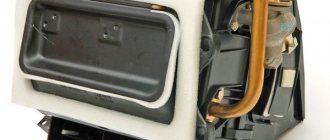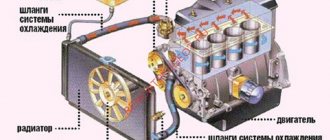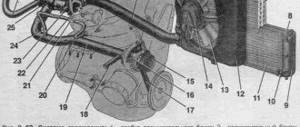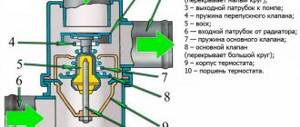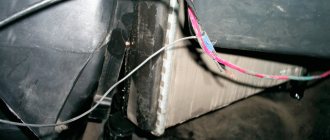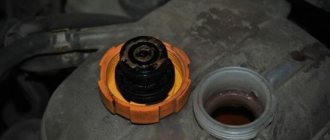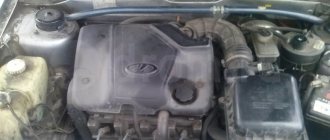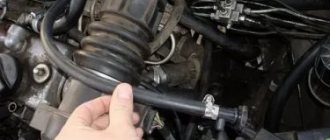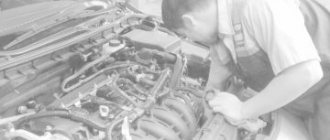The cooling system of any engine consists of two circuits - main and small. When air appears in the antifreeze, the small circuit practically stops working. The stove does not heat, and they look for the reason in the thermostat and change it, although it is necessary to get rid of the air lock. On injection engines, such as on the Lada VAZ-2114, it will be easy to expel air from the cooling system: the throttle assembly and access to it always remains open. There is also access to the expansion tank, and nothing else is needed.
If the tank is constantly swelling, this also needs to be dealt with. The video shows exactly how.
Preparation
The 11183 engine has a plastic casing that can be removed by simply pulling the part up. You can first unscrew the oil filler plug.
Motor “11183” and its protective casing
The temperature regulator in the cabin is moved to the right position. Without this, all actions will be useless.
Using method 1, the engine is first warmed up. For methods 2 and 3, the engine is left without warming up.
Removing an air lock in the cooling system on a Priora
Welcome! An air lock - it can be created anywhere, namely in the engine cooling system, also sometimes air gets into the braking system and the car starts to brake very, very poorly (If there is a lot of air, the car will not brake at all), but also with with the cooling system, everything is not so clear; when air gets into it, the car’s engine, the first thing that starts to heat up too much and eventually overheats, in addition to this, the heater will still work poorly (the air from it will come out cold, when the car’s engine is warmed up ) and therefore air must be expelled from any system; in the brake system this is done using fittings and a hose with a bottle, but with the cooling system everything is simpler and no bottle or hose will be needed to expel the plug from the system.
Note! To remove the air lock from the system, you just need to find: A slight slope, and you may also need a screwdriver, so stock up on that!
Summary:
When should you remove an air lock in the cooling system? If you have recently begun to notice that the car has begun to heat up very much, and you have recently replaced the coolant with a new one and before that, the car did not heat up so much even with the old coolant, this indicates that air has entered the system and the fluid was replaced incorrectly, in addition, in order to be 100% sure that the system is aired, turn on the heater when the car’s engine is fully warmed up (the heater should be working in this case) and see what kind of air comes out of it, if slightly warmed up then in this case In this case, your heater fan is broken and needs to be replaced, but if cold air comes out when the engine is warm, then this indicates that there is a plug in your cooling system.
Three different methods for removing air from the cooling system
It is always necessary to expel the air after a complete change of antifreeze!
Let's see how the throttle assembly on the 11183 engine is arranged. Antifreeze flows through hoses 1 and 3, and hose 2 is a tube with air (do not touch).
Pipes on the throttle assembly VAZ-11183
Method 1 (remove the hoses on the throttle body)
If the engine has been warmed up, remove either of the two hoses by placing a container under it. 100-200 ml of liquid may leak out . The hose is immediately returned to its place, the fastener is tightened, and antifreeze is added through the neck of the tank. “Method 1” is discussed here.
When working according to “method 1”, the tank is not opened at first. To loosen the fastening clamp, you will need a Phillips screwdriver. All manipulations with hot antifreeze are carried out with caution.
The first time the air usually comes out. But, if the procedure is repeated, the plug can be completely removed.
Method 2 (tank cap off)
The engine remains cold. Open the tank cap. Then we do it as in “method 1” (see photo).
Pipes on the throttle assembly of the VAZ-2111
As you can see, antifreeze does not leak. Let's help him a little:
- We take the tube, bring it to the tank and create an airtight seal with our fingers;
The tank is ready for use
- Blow into the tube, placing the container under the hose removed from the throttle assembly;
- If antifreeze begins to flow into the empty container, return the hose to its place;
- Tighten the fastening, add antifreeze.
This method is universal. It is used on any car, including the VAZ-2114, and it is possible to expel air from the system immediately.
Method 3 (remove air without disassembling parts)
Let's consider the simplest method. You don't have to disassemble anything:
- We place the car on an overpass or hill so that the upper part of the radiator is higher than other parts;
- Open the cap on the expansion tank;
- We start the engine. The system will warm up;
- The antifreeze level may drop abruptly. The liquid is then added.
The point is that a steam exhaust hose is connected to the radiator. Air will escape through it into the tank.
Steam outlet on the tank (do not remove!)
It will be possible to increase the engine speed, but then make sure that the antifreeze does not boil . With the cover removed, this option is not excluded!
Read more about the main reasons for antifreeze boiling on the VAZ-2114 here.
How to bleed air from the cooling system - all methods
On many vehicle models, getting rid of an air lock in the coolant system is quite easy and even a non-professional can do, which will save a significant amount.
ATTENTION. Before carrying out this procedure, the sources of air in the system should be eliminated.
There are three methods for bleeding air yourself:
1) It is necessary to place the car on a level surface and remove the upper protection from the motor. In many models, the throttle assembly is the highest point in the cooling system.
If, during a visual inspection, the same feature is found on a specific model of vehicle, then to bleed the air it is necessary to remove the antifreeze supply pipe from the throttle assembly by loosening the clamp with a Phillips screwdriver; it would not be superfluous to open the heater switch to the hottest mode (this procedure is especially relevant for VAZs ).
Then you should unscrew the cap from the expansion tank and cover the hole with a clean cloth and start blowing air into the tank with your mouth until coolant begins to pour out of the pipe, which will mean removing the plug. Then you should secure the pipe and screw on the cap.
2) You should first warm up the internal combustion engine for 10-20 minutes (depending on the outside temperature). Then unscrew the cap from the expansion tank and remove the antifreeze supply pipe from the throttle module.
After coolant begins to flow out of the pipe, it should be returned to its place, carefully securing the clamp. When carrying out this procedure, it is necessary to avoid contact of the working fluid with the skin and clothing to avoid burns.
3) It is necessary to put the vehicle on the handbrake on an inclined surface (with the front part on the rise); additional wheel chocks will not be superfluous.
Next, you should start the engine and let it run for 10-20 minutes to heat the coolant and open the thermostat. Then carefully, so as not to get burned, you should remove the cap from the expansion tank and radiator.
During this procedure, you should regularly lightly depress the accelerator pedal and add antifreeze (antifreeze), it would not be superfluous to turn on the stove to the hottest setting to bleed air from the heating system.
The release of the plug will be manifested by the appearance of bubbles; after they completely disappear and/or very hot air appears from the heating system, you can turn off the engine and return the covers to their place, as this will mean complete removal of air from the cooling system.
Two important notes
When working according to method 1 or 2, the container is placed under both the hose and the throttle body pipe. It is not known which side the antifreeze will come from first. The brand of liquid is chosen as follows:
- Blue or green antifreeze can be diluted with antifreeze class G11 (green);
- Antifreeze class G12 (but not G11) can be added to red liquid.
Be careful: all antifreezes are usually sold in the form of a concentrate!
Liquid class G11
Troubleshooting methods
Coolant hoses
There are three possible options for removing an air lock from the cooling system:
- Through the expansion tank with removal of the pipe.
- Without disassembling, by tilting the car and adding fluid.
- Using heat.
Let's take a closer look.
First option
The first option on how to remove an air lock from the cooling system is suitable for most owners of domestically produced vehicles. In these cars, it is possible to disconnect the carburetor heating hose or throttle assembly. To remove the hose, you will need to remove all parts that interfere with this procedure. Then you need to get this hose and remove it from the fitting. After this, unscrew the cap on the expansion tank and start blowing into it. As soon as the coolant begins to flow out of the hose, you must quickly return it to its place and secure the pipe with a clamp. We return all the parts to their place and enjoy the working stove.
Second option
Filling with coolant
To implement the following method of self-bleeding, you will need to drive into the inspection hole and set the car to the handbrake. Using a jack or other suitable tool, raise the front of the vehicle at a slight angle. You can achieve the same effect without a jack by placing the car on a steep incline. How to break through an air lock in the cooling system using this method? It's simple. Unscrew the caps on the expansion tank and on the radiator (if equipped). We start the engine and bring it to the optimal operating temperature. We wait for the valve to open and the liquid to move in a large circle. The switches on the stove should be set to the maximum heating level.
While the engine is warming up, it is important to monitor the fluid level in the reservoir - it should drop. Gradually add the leaving antifreeze (antifreeze)
To increase circulation and outflow of antifreeze, it may be necessary to increase engine speed. A sharp drop in the fluid level may occur, and here it is important to very quickly add it to the required level. The procedure must be continued until the air bubbles escape. After completion, you will need to lower the car and add antifreeze to the required level.
Third way
The third method will also tell you how to remove an air lock from the cooling system. For its successful implementation, you will need to start the engine and not turn it off until the optimal operating temperature is reached. After turning off the engine, remove the protective parts from it to get to the heating hose of the fitting assembly. The coolant is very hot, as are the hoses through which it flows, so protect your hands to avoid burns. You can wear two pairs of gloves - work gloves and rubber ones on top. We disconnect the hose and wait for liquid (antifreeze, antifreeze) to flow out of it. When this happens, we return everything to its place. It may happen that the antifreeze never began to flow out. In this case, return the hose to its place, unscrew the cap on the expansion tank and screw it back on. Then we try again with disconnecting the hose.
Having considered three possible options for eliminating an air lock from a vehicle’s cooling system, you only need to choose the appropriate one. One thing is for sure - it is better not to delay solving this breakdown, because the air in the system causes malfunction of the stove and serious problems with the engine, up to its complete failure.
Articles
- 21110-1008650-00 – plastic screen (only for 11183);
- 21120-1008658-00 – rubber screen pin;
- 21080-1311065-00 (-01, -03) – expansion tank plug;
- 21080-1311067-00 – gasket for the plug.
Do you only need distillate?
We tried to expel air from the system, but on the VAZ-2114 the entire “plug” takes up 100-150 ml. This means you don’t have to add anything at all to the tank. You can also add regular distilled water.
It is easier to find a 100 ml package of distillate at a pharmacy or battery store.
Solving the problem of airing the engine cooling system on Lada cars
Have you noticed that the heater in your car is blowing cold air?
There may be several reasons for the problem, but most often this occurs due to the formation of an air lock in the engine cooling system. Next, we will tell you how to remove air from the cooling system of Lada cars (Granta, Kalina, Priora, Largus, Niva, Vesta or XRAY) in several ways. Let us remind you that AvtoVAZ installs the same type of power units on its models, so the instructions are similar for all Lada cars.
Reasons for the appearance of an air lock in the chimney
An air lock occurs due to increased humidity in the chimney. This leads to high air density, which interferes with natural draft. Most often, this problem arises due to gross mistakes made during the construction of the chimney.
Here are some of the most common mistakes:
- Lack of insulation. Some people, wanting to save money, use single-wall pipes for the outer part of the chimney. Their main disadvantage is that in winter they freeze very much. The escaping gases cool very quickly, causing condensation to form. This contributes to an increase in humidity inside the pipe, which leads to increased humidity. Such chimneys require mandatory insulation or replacement with sandwich pipes that have a heat insulator inside.
- Curvature or ill-conceived design. Sometimes mistakes are made at the design stage. Then, in the outer part of the chimney, the escaping gases will cool faster, which will also lead to the formation of condensation.
- Installation of the deflector. A chimney deflector is installed to increase draft and prevent backdraft in strong winds. It works effectively in any wind, as it prevents the penetration of air currents into the pipe. As a result, the wind does not disrupt the movement of the main flow of exhaust gases. In calm weather or light winds, the deflector acts as an umbrella. It prevents the release of combustion products. When the escaping gases come into contact with it, condensation forms due to the temperature difference. Subsequently, icicles appear on the device, the passage narrows, and the problem with the removal of combustion products only gets worse.
- Installation of the visor. It is not recommended to install canopies for chimneys of gas boilers, as they impede the movement of combustion products. Since the combustion of gas produces a large amount of water vapor, in winter frosts it turns into condensate and freezes in the form of icicles.
An air lock can occur if there is severe heat loss from the chimney due to lack of insulation, damage and other reasons. In each of these cases, the dew point within the system shifts, which leads to abundant condensation. The presence of liquid on the walls of the chimney increases humidity, which can cause an air lock to appear, which disrupts natural draft.
